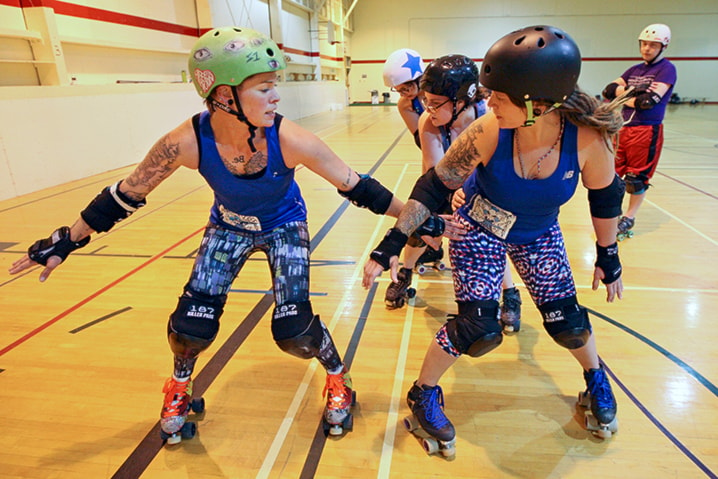There’s nothing like strapping on a pair of roller-skates and barrelling through a line of opponents to get that old adrenaline pumping.
The women of Red Deer’s Roller Derby league — players like Black Widow, Malady, Dame Tamer and Mexi-Crash — do it every game.
The sport known for female players body-checking each other to the ground while dressed in fishnet hosiery and tutus is more about skill and strategy than flashy costumes these days.
Besides the desire to be considered a sport rather than “an exhibitionist activity,” there are more practical reasons to skip the costumery: “It hurts like heck when you slide in fishnets, is all I can say …” said Bootstrap Betty, president of Central Alberta’s Nuclear-Free Roller Derby.
The up to 30 players who gather for weekly practices at the Springbrook Multiplex take the physical demands of their sport serious — although a few still maintain some kooky derby traditions, like painting their faces for game day.
Of course, their colourful derby monikers remain — as a sign of camaraderie rather than any true rivalry.
“It’s a culture all of its own,” said Bootstrap (also known as Arlene).
She uses words like “empowering” and “nurturing” to describe a sport that embraces all comers and doesn’t play favourites.
Nobody is a bench warmer. Everybody gets equal playing time.
“We don’t care what you do in life, what your career is, or your income, the colour of your skin, or your sexual preference. We care about derby and having fun on the track and looking after our teammates. This is one of the best team sports there is,” added Bootstrap.
Where else do you have two teams that play both offence and defence simultaneously while skating counterclockwise together around a circuit track?
A game of roller derby consists of a series of short match-ups or jams. Both teams appoint a jammer, who scores points by lapping members of the opposing team. Four other members are blockers, who use body contact (but never elbows) to assist their own jammer to score while blocking the opposing team’s jammer.
If it all sounds a little baffling and Quidditch-like, roller derby actually has a far longer history than the broomstick sport popularized by the Harry Potter books.
The contact sport started in the 1930s but was popularized in the 1950s when it was broadcast by TV networks. Theatrical variations with over-the-top, pro-wrestling-like plot lines arose again in the late 1980s, before a more straight-forward modern revival of the amateur sport emerged in the 200os.
There are now more than 1,200 roller derby leagues worldwide, stretching from Europe to South America and New Zealand. The sport is said to highlight the changing roles of women in many societies — which brings us back to Bootstrap Betty’s assessment.
“I think it’s confidence building,” she said.
The female players develop the kind of supportive buddy relationships that have long been part of male sports culture — to the extent that opposing team members will celebrate together after games.
Certainly the brash, roller derby attitude remains strong among the Nuclear-Free players.
In the words of Malady, 40, (a.k.a. Red Deer pattern-maker and doll artist Charity Beasley): “I like the fitness, the community and I like the hitting. It’s awesome to hit people and see them smile at you afterwards! It’s like saying, ‘Yes, they’re my buddies!’” added Malady, the group’s vice-president.
Her 11-year-old daughter trains in the junior roller derby league, which doesn’t play full-contact games. But even senior roller derby players have to go through “fresh meat” training sessions until they are deemed agile enough to not get hurt.
Mexi-Crash, 32, moved to Central Alberta from her native Mexico five years ago. The veterinarian, also known as Elizabeth Bolanos, also does kick boxing since stronger muscles mean fewer injuries. While other other players have broken a tailbone and a wrist, she’s just suffered a pulled hamstring.
Black Widow (Cassidy Tippe of Olds) showed off a fist-sized bruise on her thigh from “skidding across the floor on my hip.”
But Bootstrap contends that fewer accidents happen these days because of a focus of on proper training — including how to take falls and prevent concussions. Equipment, such as regulation helmets and knee, wrist and elbow pads, are mandatory. And all games are regulated by no fewer than seven referees.
“With 10 people on the track, there’s a lot of movement and a lot of contact,” so many eyes are needed to follow the play, she added.“There are probably more roles than any other sport there is,” admitted referee Jeff Mitchell, known as The Jester. He’s one of a relatively few Albertan males who play the sport in a separate men’s league.
The Jester said he started participating in roller derby because it’s a good way to meet women through co-ed games and he continues to play because it’s fun.
Black Widow, a 27-year-old college student, said, “I play because of the awesomeness of the girls, and the team environment. … We’re like a derby family.”
Since the sport crosses cultural lines, one of the first things Mexi-Crash did after moving to Bentley with her boyfriend was locate a local roller derby league. “I like that it’s just girls and that it’s rowdy.”
The next game day is set for Oct. 17, when the Nuclear-Free team is pitted against the Tarsand Bettys from Fort McMurray. For more information about the game or joining the league, visit nuclearfreerollerderby.ca or email nuclearfreederby@gmail.com.
lmichelin@www.reddeeradvocate.com
